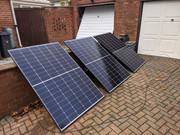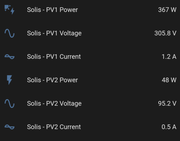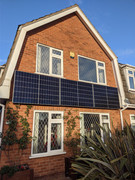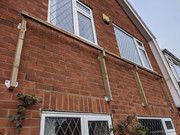PV Expansion - Wall Mounted Experimentation
Posted: Wed Nov 16, 2022 12:29 pm
Several months ago I installed a 10 panel 4kWp array on my garage roof, tied into a 3.6kW Solis inverter.
Performance has been good, but now that we're firmly on the way towards the winter the 5 degree pitch is rapidly losing ground.
Normally I'd shrug and just accept the drop off in performance, but that would be far too easy!
Instead, thoughts turned to the front wall of my house....
Facing almost directly south with extremely low shading, it could be a great winter PV addition.
Measurements indicate I can fit 3 panels in landscape between the ground floor and upstairs windows, spanning the full width of the house. I did consider the upper gable wall, but structural concerns and access issues have put me off.
So, I put in an order for 3 Longi 405w panels from ITS, ready to experiment further. These arrived yesterday with no damage and ready to go.
Of course, nothing is always quite as simple as it might appear...
The main issue I needed to check was how well this would work with the Solis inverter.
The garage array used 1 MPPT, leaving the second for the front wall which is great. Unfortunately, the datasheet indicates that the start-up voltage is 120v, above the 90v or so the new array will produce. Additionally, it's only just at the very edge of the MPPT range.

I'm expecting this to be ok though, as I've seen the Solis start the main array at 75v every morning.
I set the panels up temporarily, leaning against a wall and facing the house on an incredibly cloudy day - basically worst case scenario.

Connected them to MPPT 2, turned the PV isolator back on and... it's alive!

The graph shows how the new array settled at about 90v, only dropping down when I used the PV isolator to kill the main array

It looks like the Solis can indeed work with just 90v of panels, I assume the higher start-up voltage on the datasheet is to cover situations where the inverter has no DC input power from batteries, and is 100% solar powered.
As you can see, the performance of both arrays is dire today but that's entirely down to the weather.
The next step is to finalise the mounting design on the front wall and get them up there!
Performance has been good, but now that we're firmly on the way towards the winter the 5 degree pitch is rapidly losing ground.
Normally I'd shrug and just accept the drop off in performance, but that would be far too easy!
Instead, thoughts turned to the front wall of my house....
Facing almost directly south with extremely low shading, it could be a great winter PV addition.
Measurements indicate I can fit 3 panels in landscape between the ground floor and upstairs windows, spanning the full width of the house. I did consider the upper gable wall, but structural concerns and access issues have put me off.
So, I put in an order for 3 Longi 405w panels from ITS, ready to experiment further. These arrived yesterday with no damage and ready to go.
Of course, nothing is always quite as simple as it might appear...
The main issue I needed to check was how well this would work with the Solis inverter.
The garage array used 1 MPPT, leaving the second for the front wall which is great. Unfortunately, the datasheet indicates that the start-up voltage is 120v, above the 90v or so the new array will produce. Additionally, it's only just at the very edge of the MPPT range.

I'm expecting this to be ok though, as I've seen the Solis start the main array at 75v every morning.
I set the panels up temporarily, leaning against a wall and facing the house on an incredibly cloudy day - basically worst case scenario.

Connected them to MPPT 2, turned the PV isolator back on and... it's alive!

The graph shows how the new array settled at about 90v, only dropping down when I used the PV isolator to kill the main array

It looks like the Solis can indeed work with just 90v of panels, I assume the higher start-up voltage on the datasheet is to cover situations where the inverter has no DC input power from batteries, and is 100% solar powered.
As you can see, the performance of both arrays is dire today but that's entirely down to the weather.
The next step is to finalise the mounting design on the front wall and get them up there!


